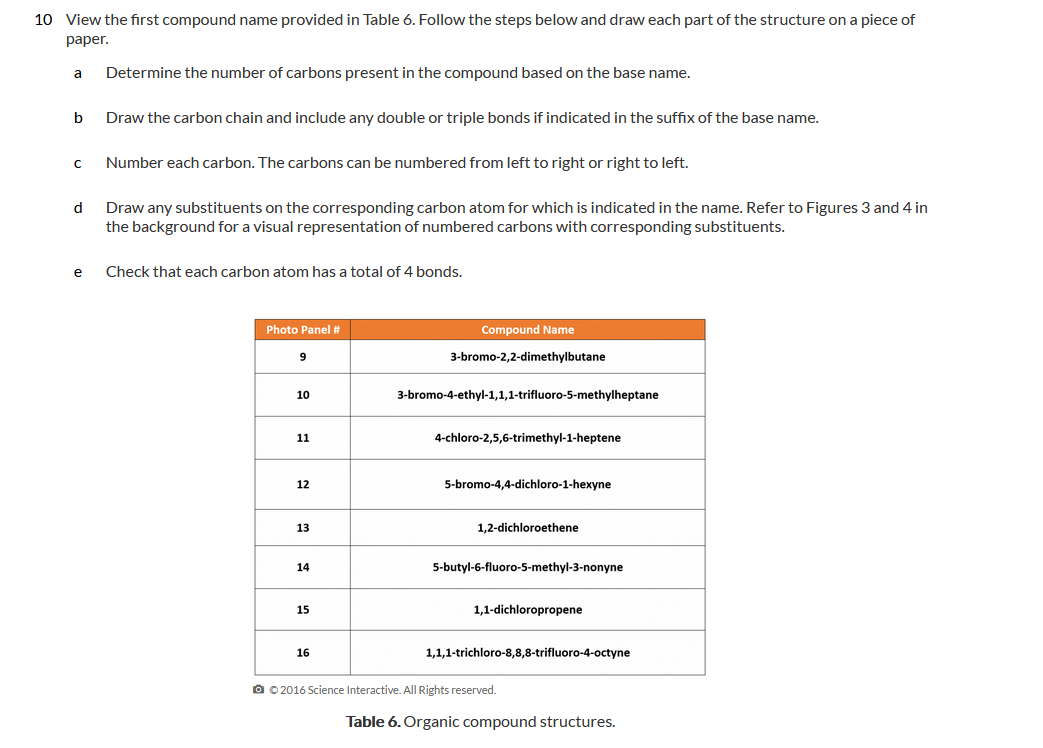View the first compound name provided in Table 6. Follow the steps below and draw each part of the structure on a piece of рaper. a Determine the number of carbons present in the compound based on the base name. b Draw the carbon chain and include any double or triple bonds if indicated in the suffix of the base name. Number each carbon. The carbons can be numbered from left to right or right to left. d Draw any substituents on the corresponding carbon atom for which is indicated in the name. Refer to Figures 3 and 4 in the background for a visual representation of numbered carbons with corresponding substituents. e Check that each carbon atom has a total of 4 bonds. Photo Panel # Compound Name 3-bromo-2,2-dimethylbutane 10 3-bromo-4-ethyl-1,1,1-trifluoro-5-methylheptane 11 4-chloro-2,5,6-trimethyl-1-heptene 12 5-bromo-4,4-dichloro-1-hexyne 13 1,2-dichloroethene 14 5-butyl-6-fluoro-5-methyl-3-nonyne 15 1,1-dichloropropene 16 1,1,1-trichloro-8,8,8-trifluoro-4-octyne O 0 2016 Science Interactive. All Rights reserved. Tablo 6 Organic c ompound ctrCucturor
View the first compound name provided in Table 6. Follow the steps below and draw each part of the structure on a piece of рaper. a Determine the number of carbons present in the compound based on the base name. b Draw the carbon chain and include any double or triple bonds if indicated in the suffix of the base name. Number each carbon. The carbons can be numbered from left to right or right to left. d Draw any substituents on the corresponding carbon atom for which is indicated in the name. Refer to Figures 3 and 4 in the background for a visual representation of numbered carbons with corresponding substituents. e Check that each carbon atom has a total of 4 bonds. Photo Panel # Compound Name 3-bromo-2,2-dimethylbutane 10 3-bromo-4-ethyl-1,1,1-trifluoro-5-methylheptane 11 4-chloro-2,5,6-trimethyl-1-heptene 12 5-bromo-4,4-dichloro-1-hexyne 13 1,2-dichloroethene 14 5-butyl-6-fluoro-5-methyl-3-nonyne 15 1,1-dichloropropene 16 1,1,1-trichloro-8,8,8-trifluoro-4-octyne O 0 2016 Science Interactive. All Rights reserved. Tablo 6 Organic c ompound ctrCucturor
Organic Chemistry: A Guided Inquiry
2nd Edition
ISBN:9780618974122
Author:Andrei Straumanis
Publisher:Andrei Straumanis
Chapter18: Aromaticity
Section: Chapter Questions
Problem 1CTQ
Related questions
Question
View the first compound name provided in Table 6. Follow the steps below and draw each part of the structure on a piece of paper.
- Determine the number of carbons present in the compound based on the base name.
- Draw the carbon chain and include any double or triple bonds if indicated in the suffix of the base name.
- Number each carbon. The carbons can be numbered from left to right or right to left.
- Draw any substituents on the corresponding carbon atom for which is indicated in the name. Refer to Figures 3 and 4 in the background for a visual representation of numbered carbons with corresponding substituents.
- Check that each carbon atom has a total of 4 bonds.

Transcribed Image Text:10 View the first compound name provided in Table 6. Follow the steps below and draw each part of the structure on a piece of
рaper.
a
Determine the number of carbons present in the compound based on the base name.
b
Draw the carbon chain and include any double or triple bonds if indicated in the suffix of the base name.
Number each carbon. The carbons can be numbered from left to right or right to left.
d
Draw any substituents on the corresponding carbon atom for which is indicated in the name. Refer to Figures 3 and 4 in
the background for a visual representation of numbered carbons with corresponding substituents.
e
Check that each carbon atom has a total of 4 bonds.
Photo Panel #
Compound Name
9
3-bromo-2,2-dimethylbutane
10
3-bromo-4-ethyl-1,1,1-trifluoro-5-methylheptane
11
4-chloro-2,5,6-trimethyl-1-heptene
12
5-bromo-4,4-dichloro-1-hexyne
13
1,2-dichloroethene
14
5-butyl-6-fluoro-5-methyl-3-nonyne
15
1,1-dichloropropene
16
1,1,1-trichloro-8,8,8-trifluoro-4-octyne
O 0 2016 Science Interactive. All Rights reserved.
Table 6. Organic compound structures.
Expert Solution
This question has been solved!
Explore an expertly crafted, step-by-step solution for a thorough understanding of key concepts.
This is a popular solution!
Trending now
This is a popular solution!
Step by step
Solved in 3 steps with 3 images

Knowledge Booster
Learn more about
Need a deep-dive on the concept behind this application? Look no further. Learn more about this topic, chemistry and related others by exploring similar questions and additional content below.Recommended textbooks for you

Organic Chemistry: A Guided Inquiry
Chemistry
ISBN:
9780618974122
Author:
Andrei Straumanis
Publisher:
Cengage Learning

Organic Chemistry: A Guided Inquiry
Chemistry
ISBN:
9780618974122
Author:
Andrei Straumanis
Publisher:
Cengage Learning